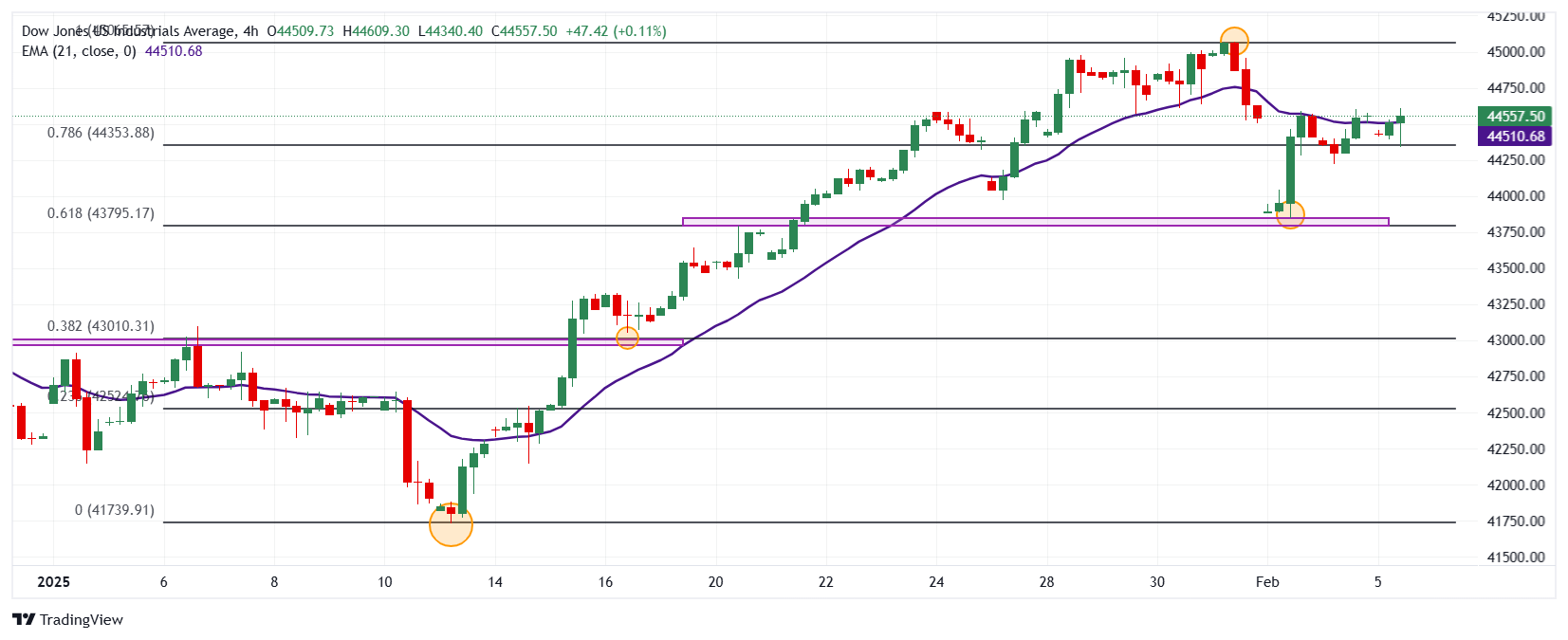- Dow Jones loses 0.26% today.
- The Nasdaq 100 falls 0.50% daily, dragged by Advanced Micro Devices (AMD) and Alphabet (Googl).
- The S&P 500 goes back 0.36% in the day, weighed by FMC Corporation (FMC).
- The ISM services PMI falls to 52.8, worsening market estimates.
- ADP employment data registered 183,000 positions in January, exceeding estimates.
The Dow Jones established a daily maximum in 44,609, where it attracted vendors that led the index to a minimum of the day in 44,390.
The Dow Jones industrial average opened at 44,433, while the Nasdaq 100 technological index began operating at 21,507. The S&P 500 initiated the negotiations in 6,013, remaining within the operational range of the previous session.
The Dow Jones remains in a negative zone weighed by UnitedHealth and Merck & Company Inc.
The Dow Jones index falls 0.26% on Wednesday, currently quoting at 44,423.
The values of Unitedhealth (UNH) lose 2.82% daily, reaching minimums not seen since January 23 in 521.91 $. In the same tune, Merck & Company Inc.’s shares (MRK) go back to 2.13%, operating when writing about 88.81 $.
The Dow Jones is consolidated within the operational range of the previous session, waiting for the definition of the next directional movement.
Advanced Micro Devices and Alphabet lead the losses in Nasdaq 100
The Nasdaq 100 technological index loses 0.47% daily, operating at the moment over 21,457.
Advanced Micro Devices titles (AMD) fall 10.41% today, reaching minimal not seen since November 2, 2023 in 106.50 $ after reporting low income in their data centers unit, obtaining 3,860 million dollars in front at 4,140 million dollars projected by investors.
On the other hand, Alphabet (Googl) values go back 10.34%, visiting minimal not seen since January 13 in 188.03 after not fulfilling expectations in their quarterly report. Googl obtained revenues for 96.47 billion dollars, below 96.68 billion dollars.
The S&P 500 is quoted by Xylem Inc. and Super Micro Computer
The S&P 500 index falls 0.18% in the day, operating at this time in 6,024.
FMC Corporation shares (FMC) collapse 36.34% today, reaching a minimum of April 14, 2016 in 34.00 $ after a lousy quarterly report. FMC obtained revenues of 1.2 billion dollars compared to the 1.32 billion dollars projected by the market.
Based on the information presented by Automatic Data Processing (ADP), employment in the US private sector registered 183,000 positions in January, above the expected 150,000 and the 176,000 registered the previous month.
In contrast, the ISM services PMI stood at 52.8 points, below 54.3 estimated and 54.4 reached in December.
Technical Analysis of Dow Jones
The Dow Jones established a short -term support given by the minimum of February 3 in 43,848. The following important support is 43,048, minimum of January 16, in convergence with the 38.2% fibonacci setback. To the north, the key resistance is located at 45,068, maximum of January 31.
4 -hour graph of Dow Jones

Dow Jones Faqs
The Dow Jones Industrial Avenge, one of the oldest stock market indexes in the world, consists of the 30 most negotiated values in the United States. The index is weighted by the price instead of capitalization. It is calculated by adding the prices of the values that compose it and dividing them by a factor, currently 0.152. The index was founded by Charles Dow, also founder of the Wall Street Journal. In recent years it has been criticized for not being sufficiently representative, since it only follows 30 companies, unlike broader rates such as S&P 500.
There are many factors that promote the Dow Jones Industrial Average (DJIA) index. The main one is the added performance of the companies that compose it, revealed in the quarterly reports of business benefits. The American and world macroeconomic data also contribute, since they influence investor confidence. The level of interest rates, set by the Federal Reserve (FED), also influences the DJia, since it affects the cost of credit, on which many companies depend largely. Therefore, inflation can be a determining factor, as well as other parameters that influence the decisions of the Federal Reserve.
Dow’s theory is a method to identify the main trend of the stock market developed by Charles Dow. A key step is to compare the direction of the Dow Jones Industrial Avenge (DJIA) and the Dow Jones Transportation Average (DJTA) and just follow the trends in which both move in the same direction. The volume is a confirmation criterion. The theory uses elements of maximum and minimum analysis. Dow’s theory raises three phases of the trend: accumulation, when intelligent money begins to buy or sell; Public participation, when the general public joins the trend; and distribution, when intelligent money abandons the trend.
There are several ways to operate with the DJ. One of them is to use ETF that allow investors to negotiate the DJ as a single value, instead of having to buy shares of the 30 companies that compose it. An outstanding example is the SPDR Dow Jones Industrial Avenge ETF (day). Future contracts on the DJ allow the specular operators about the future value of the index and the options provide the right, but not the obligation, to buy or sell the index at a predetermined price in the future. Investment funds allow investors to buy a part of a diversified portfolio of DJ values, which provides exposure to global index.
Source: Fx Street
I am Joshua Winder, a senior-level journalist and editor at World Stock Market. I specialize in covering news related to the stock market and economic trends. With more than 8 years of experience in this field, I have become an expert in financial reporting.







